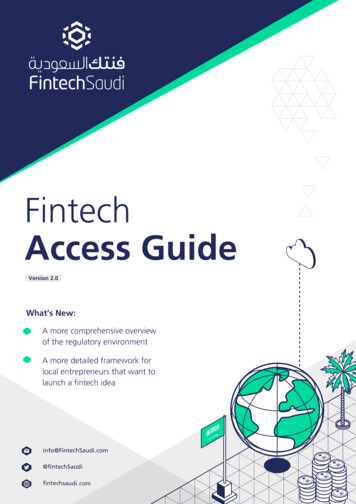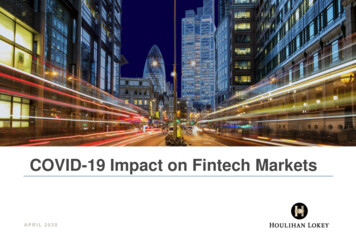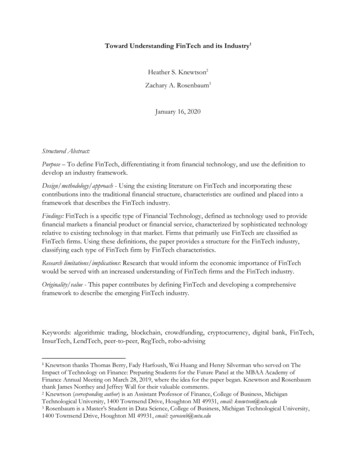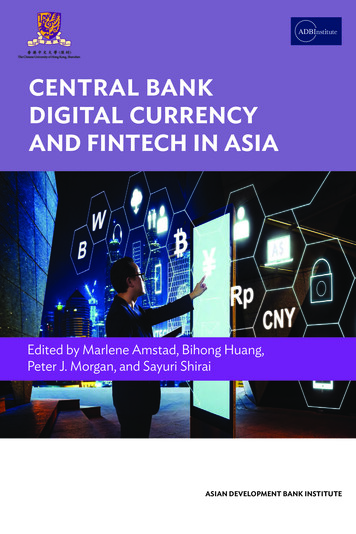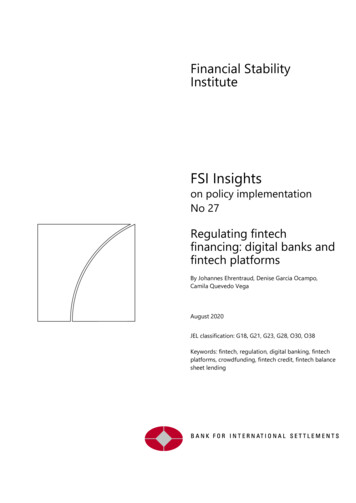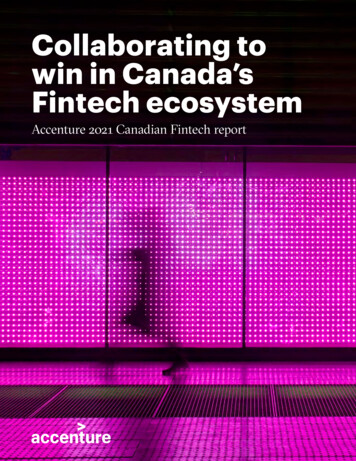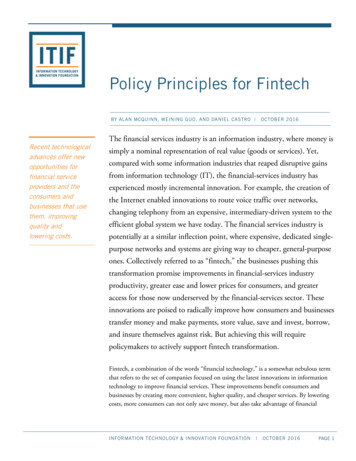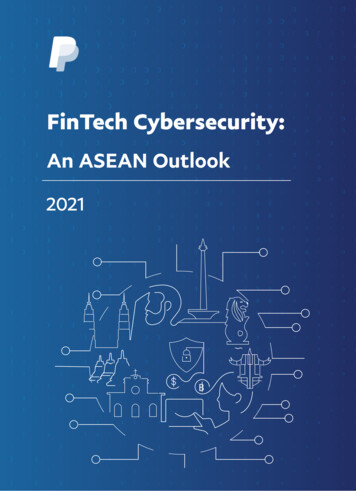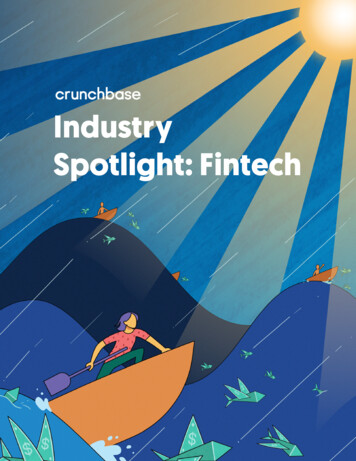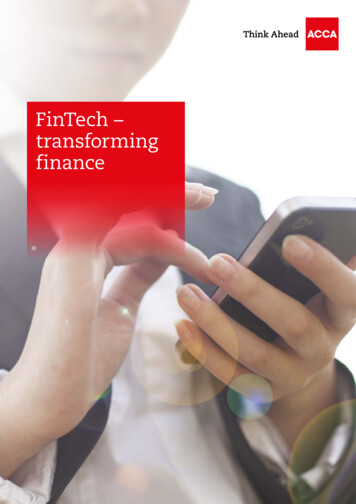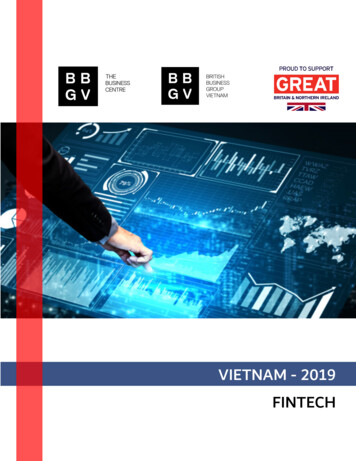
Transcription
VIETNAM - 2019FINTECH
This report was produced by the Business Centre of The British Business Group Vietnam(BBGV) with references from sources believed to be accurate and reliable at the time ofpublishing. Individuals, companies and organisations are required to acknowledge BBGVwhen using this work for any papers or publishing purposes. We are not responsible for anyloss or damage resulting from opinion, errors, inaccuracies or omissions affecting any part ofthe content.1
I. Introduction:According to “ASEAN FinTech Census 2018” from Ernst & Young, Vietnam currently ranks second amongstASEAN member states in the number of incubators, accelerators, and innovation labs in the region. The VietnameseFintech market was worth 4.4 billion in 2017, and is predicted to reach 7.8 billion by 2020, equalling a 77% increaseover three years1. Fintech development in Vietnam is accelerating with companies in the sector attracting US 117million in startup capital, surpassing e-commerce at US 104 million and other sectors2 which makes Fintech the mostfunded sector for start-ups in 2018.The Vietnamese Fintech start-up ecosystem is now home to more than 120 companies and brands covering a broadrange of services, from digital payments and alternative finance, to wealth management and blockchain.Table: Fintech Vietnam start-up map 2019Source: Fintechnews.sg1 Casey Hynes, How Vietnam's Fintech Market Could Reach Nearly 8 Billion By 2020, Forbes, May 18, lion-by-2020/#196efd24456f2 Nguyen Tung, Vietnam’s top 5 most-funded fintechs in 2018, Hanoi Times, Feb 23, 385/vietnam-s-top-5-most-funded-fintechs-in2-018/2
FinTech in Vietnam mostly focuses on payments with 47 % of Vietnamese companies working on payment services3,the highest rate in the region. Cashless payments are booming in Vietnam, more than doubling in value over the firstthree quarters of 2018. In particular, payments through mobile banking services have surged to 144% per year overthe past five years4; transactions over mobile apps and digital wallets rose by an impressive 126% and 161%respectively5. A report published in late 2018 by Allied Market Research estimated that the Vietnamese mobilepayment market could reach US 70,937 million by 2025. Notable companies and brands in this segment include:- M Service: providing financial services for the population in Vietnam through mobile phone technology under thebrand name of MoMo. MoMo started out offering an e-wallet and mobile payment app, enabling users to pay onlineand make peer-to-peer (P2P) transfers. As of October 2018, MoMo had nearly 10 million users on both iOS andAndroid and was named one of the 2018 Fintech 100 Leading Global Fintech Innovators by H2 Ventures and KPMGlast year6. According to a report by Ernst & Young (EY) MoMo recently received an investment of US 33.75 millionfrom Goldman Sachs and Standard Chartered and 100 million from U.S. private equity firm Warburg Pincus.- Moca: a free mobile payment application for Vietnamese consumers. The company was granted a license for paymentservices by the State Bank of Vietnam (SBV) in 2016 and has a network of 11 local banks as partners. Grab last yearsigned a strategic partnership to offer digital payment services with Vietnam's Moca.- ZION: the company behind Zalo Pay, a service integrated with Vietnam’s popular messaging platform Zalo that letusers link a payment card to make P2P payments, pay via NFC, QR codes, as well as purchase products, onlineservices, mobile top-ups, and pay their utility.Peer-to-peer (P2P) lending is the second largest Fintech segment in Vietnam with over 20 start-ups. Major playersin the area include:- Tima: a consumer financial marketplace and peer-to-peer (P2P) lending platform. The company has signedpartnerships with financial institutions, including VietinBank and Nam A Bank, and claims to have disbursed aboutUS 1.7 billion in loans to 2.8 million borrowers and over 30,000 lenders on its platform. Tima claims tohave raised US 3 million Series B funding round in October at a near US 20 million valuation and recently began theprocess of raising a Series C investment7.Blockchain and cryptocurrency is another area that has witnessed significant tractions in recent years. Since thelaunch of Bitcoin Vietnam in 2014, several companies have emerged to tap into the blockchain and crypto frenzy.Notable companies include:3 129 million poured into fintech industry, Vietnam Investment review, April 14, 2018 ech-indsutry-58323.html4 Vietnam’s top 5 most-funded fintechs in 2018, Vietnam net, March 5, tml5Department of Payments at the State Bank of Vietnam Statistic.MoMo named in Fintech100 report, Vietnam News, November 5, med-in-fintech100-report.html#oIgBl36Dx6JXGAGz.977 5 of Vietnam’s Top Funded Fintechs, Fintechnews.sg, February 21, 2019 ech-vietnam/63
- TomoChain: a public blockchain promising faster and cheaper transactions designed to support decentralizedapplications. The start-up raised US 8.5 million8 in its initial coin offering (ICO) last year and is backed by severalwell-known investment firms such as Signum Capital, Connect Capital and 1KX.Other segments present in the Vietnamese market include comparison platforms, with players such as TheBank andebaohiem, insurtech, with players like Papaya, Inso and Wicare, as well as point-of-sale (POS) system providerslike bePOS, wealth management platform like Finsify, digital banking platforms such as Timo. and credit scoringstart-ups such as TrustingSocial.II. Opportunity:Supportive government policies and ecosystem can provide a conducive environment for Fintech:1. Ecosystem:The advent of FinTech in the country can be attributed to the country’s high internet penetration of 69%, a high rateof smartphone users at 72% as of January 20199 and rapidly growing e-commerce. The percentage of unbankedpopulation is very high - only 59% of Vietnam’s population have a formal bank account, while the rest do not haveaccess to banking services10. Furthermore, the number of non-cash transactions in Vietnam is the lowest among SouthEast Asia nations. According to a World Bank survey, the number of non-cash transactions in Vietnam is 4.9 percapita compared to 59.7 in Thailand, 89 in Malaysia and 26.1 in China respectively. This creates a big opportunity forFinTech.There are also several accelerator programmes in the country giving assistance to start-ups. For instance, the VietnamInnovative Start-up Accelerator (VIISA) has invested US 6 million in start-ups to help build global companies inVietnam. The institutional support given to start-ups has led to the flourishing of many local Fintech firms. As a resultof this, investments from all over the world are pouring into Vietnamese Fintech companies.2. Government support:Vietnam has become such fertile ground for Fintech start-ups due to the government’s support in helping to foster it:8 5 of Vietnam’s Top Funded Fintechs, Fintechnews.sg, February 21, 2019, ech-vietnam/9 Vietnam Digital 2019 report, Hootsuite, January 2019SHAUN TURTON,Vietnam fintech sector set for 'bloodbath' competition, NIKKEI ASIAN REVIEW, JUNE 17, 04
Ø In January 2017, the Vietnamese Government announced an initiative aiming to significantly reduce cashtransactions and improve electronic payment methods by 2020. Under the plan, by 2020, total cashtransactions would take up less than 10% of total market transactions; all supermarkets, shopping malls anddistributors would accept credit cards; 70% of water, electronics and telecommunication service providerswould accept cash-free payments from households and individuals, and 50% of total urban households woulduse electronic payment methods for daily transactions.Ø In 2016, the government established the National Agency for Technology Entrepreneurship andCommercialisation Development (NATEC). NATEC is a platform under the Ministry of Science andTechnology which aims to provide training, mentorship, business incubation and acceleration and financialaid to new technology start-ups.Ø The government of Vietnam also has special tax schemes for start-ups under certain conditions. It will providecorporate income tax breaks for companies working in the high technology sector or in high-tech zones. Thepreferential tax rates are 10 % for 15 years or 17% for 10 years, as opposed to the regular rate of 20%.Ø Due to the lack of talented workforce available to work in high-tech companies, the Vietnamese governmentis currently focusing on STEM education (science, technology, engineering and mathematics) by organizingSTEM education in curricular teaching programs in general schools. Several leading universities have beguntraining in data science, thus the labour shortage in the field is expected to ease in three years.III. Barriers:Although Fintech in Vietnam is garnering considerable market attraction, this sector still have some barriers:IV. Further outlook:The fintech sector has a very high growth potential in Vietnam and will continue to attract funding, especially fromventure capital funds. Digital payment solutions is the current leading segment. P2P lending, the second biggest fintechinvestment sector according to a CB Insights report on Vietnamese fintech, and other fintech areas such as creditscoring, wealth management, and personal finance are in the development stage, with high potential to grow.Mergers and acquisitions (M&A) could be the future trend for fintech in Vietnam. Most banking systems in Vietnamare considered to be outdated. Therefore, acquiring a fintech firm can increase a bank’s digital footprint and shortcutthe development of new technology. Large local banks have been engaging in this fintech approach due to its benefits.According to an EY ASEAN fintech census report, 59 % of surveyed banks have budgeted to invest 10% more in5
technology in 2018, and 44% of them plan to buy new technology from third parties, while 17% are interested inacquiring a fintech company to possess its technology. With forecasted compound annual growth rates of 31.2-35.9%between 2017 and 202511, we believe that more banks will look to build their own Fintech products and that moreFintech M&As could follow in the near future.11How Vietnam will adapt to the fintech revolution, Vietnam Investment Review, September 07, -to-the-fintech-revolution-62232.html6
References:- Casey Hynes, How Vietnam's Fintech Market Could Reach Nearly 8 Billion By 2020, Forbes, May 18, lion-by2020/#196efd24456f- Nguyen Tung, Vietnam’s top 5 most-funded Fintechs in 2018, Hanoi Times, Feb 23, 385/vietnam-s-top-5-most-funded-fintechs-in2-018/- 129 million poured into Fintech industry, Vietnam Investment review, April 14, -fintech-indsutry-58323.html- Vietnam’s top 5 most-funded Fintechs in 2018, Vietnam net, March 5, tml- MoMo named in Fintech100 report, Vietnam News, November 5, med-in-fintech100-report.html#oIgBl36Dx6JXGAGz.97- 5 of Vietnam’s Top Funded Fintechs, Fintechnews.sg, February 21, 2019 ech-vietnam/- Digital 2019 Vietnam, Hootsuite, January 2019- Shaun Turton, Vietnam Fintech sector set for 'bloodbath' competition, Nikkei Asian review, June 17, nam-fintech-sector-set-for-bloodbath-competition- How Vietnam will adapt to the fintech revolution, Vietnam Investment Review, September 07, -to-the-fintech-revolution-62232.html- Department of Payments at the State Bank of Vietnam Statistic7
The fintech sector has a very high growth potential in Vietnam and will continue to attract funding, especially from venture capital funds. Digital payment solutions is the current leading segment. P2P lending, the second biggest fintech investment sector according to a CB Insights report on Vietnamese fintech
